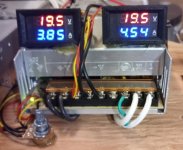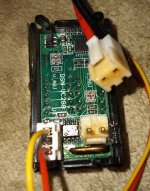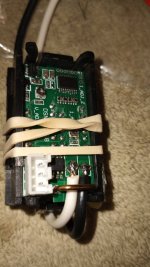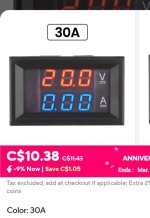It looks like 750 micro-ohms. I imagine the resistance could easily vary by a lot of micro-ohms. That meter is going to lie to you and laugh at you when you aren't looking!
That's the part that I'm worried about and that's why I wanted to get at least a high quality shunt with a stable resistance so that my results aren't all erroneous.
So you installed a shunt. I don't feel so bold!
I haven't gotten around to installing the shunt or meter yet, and I didn’t know that there was a HAL sensor option.
I thought HAL sensors only worked with AC current?
As a bit of anecdotal test, I measured the current for my power supply that's powering my lights,..
This power supply is powering 24 LED strips with 12 strips on each of the two beige 20 VDC output wires,..
It's drawing 134.1 Watts total for the 24 LED strips.
I disconnected one of beige wires and connected my ammeter between the output terminal and the wire.
(I set the ammeter to the 10 amp setting)
The power draw dropped to 110 Watts simply by having half the power running through my test leads and meter with its built-in internal shunt.
The meter was reading about 1.8 amps during the test.
If I had both outputs of the voltage supply running through the meter, I probably would have a 50 Watt drop at the outlet, just by having the power running through the meter.
(I looked into getting proper Fluke test leads for my multimeter,..
Forget that.

I'd rather spend the money on some sort of HAL sensor adapter for what I've got.)
So,...
I'm really not too keen on installing a shunt on my e-bike.
Another good thing about the HAL sensor option, is that it is completely separate from the circuit that it's measuring.
It can fail completely but not disable my ebike or create any kind of safety issue.
I'm thinking that the only way that a HAL sensor could cause problems is if it wears through the insulation on the wire it's monitoring and creates a short or something?
If it works well enough, then you face the problem of how to house the sensor and meter on the bike since neither is weatherproof.
That's the part that I'm thinking about now.
The HAL sensor itself looks like it's completely sealed but my shunts are all huge and I would hesitate from covering it with tape or silicone or whatever, thinking that might affect the resistance that could have a Huge affect on the readings?
If I'm only really going to use the meter as a Watt Hour meter once in a while to try and check my battery capacity, then I don't really need to see the display?
I can just stuff the whole thing in my down tube, or temporarily attach it somewhere (

tape, zip ties

) before my ride, then check it when my battery shuts down.
I can use my ebike display to keep an eye on the battery, and just run the e-bike until it shuts down.
Or,.. I could get this Watt Hour meter,..
It's a complete meter with the HAL sensor, and it could actually replace my ebike display?
It won't show my speed, but I don't really care because I set my ebike to 32kph maximum anyway.
I'm not sure what I'm going to do?
I could actually just temporarily attach the meter display on top of my ebike display if I'm only using it occasionally to check my capacity?
My ebike display has dummy gages for the voltage, amperage, and power though, and the battery monitor doesn't have all kinds of AI crap fudging all the numbers.

This display is all I really need,..
The only things I really care about now is the actual voltage and current in real time so I have an idea about how fast I'm draining the battery.
I would trust this display to tell the truth without any logarithmic crap turning the actual numbers into what it thinks that I need to see.
I figure that the only built-in fudge factor is the "damping" and sample rate averaging to make the display readable.
My ebike display takes a full 10 seconds to read zero after I hit the brake and kill the power.
I don't like that.
It should read "0" the instant I hit the brake lever.








